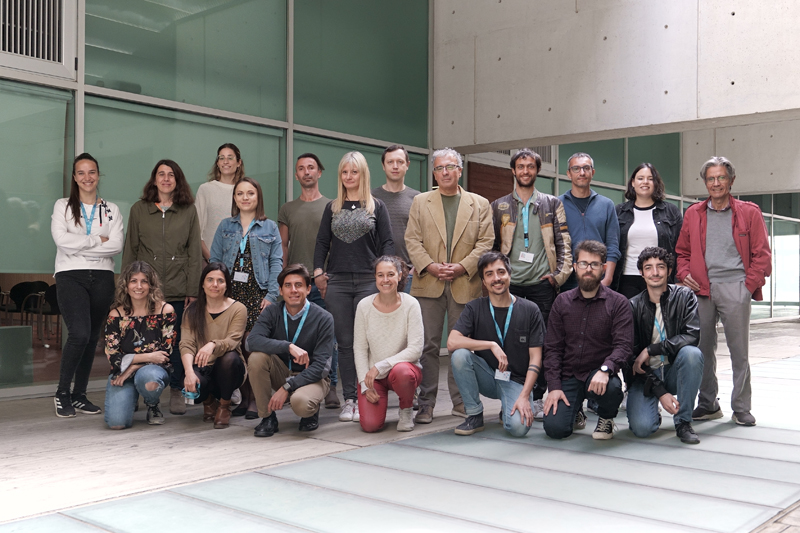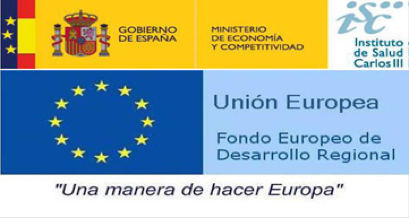 Guigó Lab
Guigó Lab
 Computational Biology and Health Genomics
Computational Biology and Health Genomics
- Group page
- Research lines
- Group members
- Publications
- Datasets
- Software
1988 Ph.D. in Statistics. Universitat de Barcelona. (Spain).
1988-1993 Postdoctoral researcher at the Molecular Biology Computer Research Resource. Dana Farber Cancer Institute, Harvard University (Division of Biostatistics) BioMolecular Engineering Research Center. Boston University and Theoretical Biology and Biophysics Group (Los Alamos National Laboratory).
1994-2010 Investigator at Institut Municipal d’Investigació Mèdica (IMIM). Barcelona, (Spain).
2001-2005 Associate Professor at the Universitat Pompeu Fabra. Barcelona, (Spain).
2001-2022 Coordinator of the Bioinformatics Programme at the Centre de Regulació Genòmica, Barcelona, (Spain).
Since 2005 Professor at the Universitat Pompeu Fabra. Barcelona, (Spain).
See also the Roderic Guigó lab website
News
Earth BioGenome project begins efforts to sequence 40 thousand genomes in the Catalan Countries (18/07/2024)
Sequencing the genomes of all plants, animals, and fungi on Earth—nearly two million known species—can protect biodiversity as we know it. This is the aim of the Earth Biogenome Project (Earth BioGenome Project, EBP), which aims to characterise the genomic biodiversity of species in different regions of the planet.
CRG researchers promote inclusion of local languages in scientific publications (27/06/2024)
The researchers also translated the scientific abstract of the study, a short summary of the research which is usually written in the first pages of a scientific publication, in Catalan.
Expedition begins to chart the invisible biodiversity of Pyrenean lakes (16/04/2024)
Researchers from Spain, Andorra and France have begun efforts to chart the biodiversity of microorganisms living under the surface of 300 different lakes across the Pyrenees.
Epigenome mapped in detail across human body (30/03/2023)
An international research collaboration has addressed this challenge by cataloguing the human epigenome in unprecedented detail, charting the whole collection of epigenomic marks in more than 25 different types of tissues across the human body.
‘Space bacteria’ set to land in Barcelona (16/03/2023)
A new collaboration between the CRG and yuri GmbH, a commercial space biotechnology company in Germany, will bring together researchers to harness the power of microgravity conditions in space and study its impact on human health, cells, and plant biology.
Seasonal and circadian genetic variation charted across the human body (13/02/2023)
A research team at the CRG have published research in PLOS Biology which details how the circadian and circannual cycles influence humans at the molecular level by measuring changes to the activity of genes inside cells across different types of tissues.
CRG joins international efforts to protect human health from effects of harmful chemicals (11/03/2021)
Roderic Guigó will lead the CRG's contributions to the international consortium
CRG signs biodiversity genomic sequencing agreement with Andorra (01/03/2021)
This is the first time the country has been involved in a project of this magnitude
Small but ubiquitous sex differences in gene expression in human tissues linked to body fat, cancer, and birth weight (10/09/2020)
A study published today in Science reveals that biological sex has a small but ubiquitous influence on gene expression in almost every type of human tissue.
Human body mostly composed of just five major groups of cell (30/07/2020)
Scientists around the world have today published the results of the third phase of the Encyclopedia of DNA Elements (ENCODE) in Nature.
A study describes the dynamics of chromatin during organ and tissue regeneration (04/12/2018)
Researchers discover the genes and regulatory elements of their expression that are required during the process of tissue and organ regeneration in the fruit fly. The article appears highlighted in the cover of the Genome Research journal in December.
Roderic Guigó and Toni Gabaldón among the most highly cited researchers in the world (30/11/2018)
Two CRG group leaders are among the most highly cited researchers in the world, according to the list established by Clarivate Analytics.
Roderic Guigó receives the National Research Award (19/10/2018)
Roderic Guigó, coordinator of the CRG Bioinformatics and Genomics Programme, received the National Research Award. The award ceremony took place at the National Theatre of Catalonia in Barcelona on 15th October and it was chaired by the President of the Catalan Government, Mr. Quim Torra.
Gene expression patterns may help determine time of death (13/02/2018)
International team of scientists led by CRG programme coordinator Roderic Guigó shows that changes in gene expression in different tissues can be used to predict the time of death of individuals.
National Research Award 2017 to Roderic Guigó (27/12/2017)
Roderic Guigó, coordinator of the CRG Bioinformatics and Genomics Programme, honored with the highest recognition for research excellence in Catalonia.
A new method accelerates the mapping of genes in the “Dark Matter” of our DNA (06/11/2017)
Scientists at the Centre for Genomic Regulation (CRG) in Barcelona, have developed a new method, which improved the most important catalogue of genes -GENCODE-, including characterization of new genes in the DNA “Dark Matter”.
Genome Editing: Pressing the «Delete» Button on DNA (02/03/2017)
Until recently, genomics was a «read-only» science. But scientists led by Rory Johnson at the University of Bern and the Centre for Genomic Regulation in Barcelona, have now developed a tool for quick and easy deletion of DNA in living cells. This software will boost efforts to understand the vast regions of non-coding DNA, or «Dark Matter», in our DNA and may lead to discovery of new disease-causing genes and potential new drugs.
Spanish scientists sequence the genome of the Iberian lynx, the most endangered felid (14/12/2016)
Genomic analysis of the Iberian lynx confirms that it is one of the species with the least genetic diversity among individuals, which means that it has little margin for adaptation.
The Blueprint project celebrates major manuscript release (18/11/2016)
BLUEPRINT scientists, including researchers at the Centre for Genomic Regulation, release a collection of 25 publications in Cell, Cell Press-associated and other high-impact journals. These are part of a package of 41 publications by the International Human Epigenome Consortium (IHEC) of which BLUEPRINT is a member.
'Blueprint' study of epigenetics of blood cells will serve biology and medicine (07/09/2016)
Researchers from the EU-funded BLUEPRINT project join their international colleagues this week at the 2016 International Human Epigenome Consortium (IHEC) conference in Brussels to report the latest results in understanding blood cell development and blood disease.
CRG researchers contribute to the sequencing of the Turbot genome (09/03/2016)
The first vertebrate to be genetically sequenced in Spain, the Turbot (Scophthalmus maximus), has a much more refined visual system than other fish as it has evolved to adapt to the shortage of light of the seabed. In addition, the fat in its cell membranes are far higher than in other species to withstand the low water temperatures in its habitat.
The mesoamerican bean genome decoded (25/02/2016)
An Ibero-American team of scientists decoded the Mesoamerican variety of the bean genome coinciding with the celebration of the International Year of Pulses, as designated by the United Nations.
Funding acknowledgements


The "VEIS-Valorisation of EGA for Industry and Society" (VEIS-001-P-001647) project is cofunded by the European Regional Development Fund of the European Union in the framework of the ERDF Operative Program of Catalonia 2014-2020, with a grant of 1,951,429.38 EUR, with the support of the Department of Research and Universities of the Government of Catalonia.

The project “MAPAS GENETICOS Y EPIGENETICOS A LO LARGO DE LA FILOGENIA EUCARIOTA” (PID2021-128956NB-I00) is funded by Agencia Estatal de Investigación (AEI), the Ministerio de Ciencia e Innovación and Fondo Europeo de Desarrollo Regional (FEDER). Project PID2021-128956NB-I00 funded by MCIN/ AEI / 10.13039/501100011033 / FEDER, UE



The 'IMPaCT' project, with official reference IMP/00019, has been granted by the ISCIII, under the Infraestructura de Medicina de Precisión asociada a la Ciencia y Tecnología (IMPaCT) - Ciencia de Datos Call, the Spanish Ministry of Science and Innovation, and cofunded with ERDF Funds from the European Union.
Period: 01/01/2021 to 31/12/2023
Ref.: IMP/00019

The project 'Omplint el buit del mercat del single cell', granted under the call from 'Industria del Coneixement (Llavor i Producte), has received funding from the Department of Research and Universities, of the Government of Catalonia
Period: 19/10/2022 to 18/04/2024

The project “GENCODE: comprehensive reference genome annotation for human and mouse” has been granted by the NATIONAL INSTITUTE OF HEALTH – NIH with reference 2U24HG007234-09 .
Period: 14/09/2021 to 30/06/2025
Ref.: 2U24HG007234-09

The project 'Long-TREC: The Long-Reads Transcriptomics European Consortium. The next generation transcriptome biology revealed by single molecule sequencing technologies' has received funding from the European Union's HORIZON-MSCA-2021-DN-01-01 research and innovation programme under the Marie Sklodowska-Curie grant agreement No 101072892.
Period: 01/10/2022 to 30/09/2026
Ref.: Marie Sklodowska-Curie grant agreement No 101072892
The overarching theme of the research in our group is the understanding of the information encoding in genomic sequences, and how this information is processed in the pathway leading from DNA to protein sequences. We are intrigued by the parallelism between computation and the processing of information encoded in biological sequences. The bulk of ouf research currently focuses on the mechanisms underlying RNA production (transcription) and post-processing (splicing), and it is increasingly incorporating high throughput and experimental approaches. We have recently became interested in the investigation of endophenotyes, specifically histopathological images, and we are developing computational methods to related histological features to cellular and molecular phenoytpes (mostly single-cell and bulk tissue transcriptomics) and to organismic phenotypes (i.e. diseases).
Research lines in our group are:
- Gene prediction, genome annotation, comparative genomics
- Identification and evolution of selenoproteins
- Large-scale functional genomics
- Epigenetic regulation of gene expression
- The impact of genetic variation in molecular and intermediate phenotypes

Group Leader
Senior Visiting Scientist
Staff Scientist
Postdoctoral Researchers
PhD Students
Technicians
Senior Visiting Scientist
Staff Scientist
Postdoctoral Researchers
PhD Students
Technicians
Various R scripts for exploratory biological sequence-derived data analysis
SECISaln will predict a SECIS element in the query sequence, split it into its constituent parts and align these against a precompiled database of eukaryotic SECIS elements.
SECISaln will predict a SECIS element in the query sequence, split it into its constituent parts and align these against a precompiled database of eukaryotic SECIS elements.
In this web server we provide public access to two new computational methods for selenoprotein identification and analysis:
In this web server we provide public access to two new computational methods for selenoprotein identification and analysis: SECISearch3 replaces its predecessor SECISearch as a tool for prediction of eukaryotic SECIS elements. Seblastian is a new method for selenoprotein gene detection that uses SECISearch3 and then predicts selenoprotein sequences encoded upstream of SECIS elements. Seblastian is able to both identify known selenoproteins and predict new selenoproteins. This project is the result of a collaboration with Vadim Gladyshev's lab in Harvard
Selenoprofiles is a homology-based gene finding tool which is suitable for selenoprotein prediction in large nucleotide databases, like genomes.
Selenoprofiles is a homology-based gene finding tool which is suitable for selenoprotein prediction in large nucleotide databases, like genomes. Selenoproteins are a group of proteins that contain selenocysteine (Sec), a rare amino acid inserted co-translationally into the protein chain. The Sec codon is UGA, which is normally a stop codon. In selenoproteins UGA is recoded to Sec in presence of specific signals on selenoprotein gene transcripts. Due to the dual role of the UGA codon, selenoprotein prediction and annotation are difficult tasks and are left mostly to manual analysis, since there are no reliable “golden standard” programs for this purpose. Here we present an homology-based in silico tool to scan genomes for members of the known selenoprotein families: selenoprofiles. This pipeline has features that make it suitable for selenoprotein prediction, and is shown to correctly predict selenoproteins that are badly annotated in Ensembl. Selenoprofiles is a python-built pipeline that internally runs psitblastn, exonerate, genewise and SECISearch.
sgp2 is a program to predict genes by comparing anonymous genomic sequences from different species.
sgp2 is a program to predict genes by comparing anonymous genomic sequences from different species. It combines tblastx, a sequence similarity search program, with geneid, an ab initio gene prediction program.
SJcount is a utility for fast SJ (splice-junction) quantification. It is an annotation-agnostic offset-aware version of bam2ssj
model Selection in Phylogenetics based on algebraic INvariants
sQTLseekeR is a R package to detect splicing QTLs (sQTLs), which are variants associated with change in the splicing pattern of a gene. Here, splicing patterns are modeled by the relative expression of the transcripts of a gene.
SymCurv is a computational ab initio method for nucleosome positioning prediction.
SymCurv is a computational ab initio method for nucleosome positioning prediction. It is based on the structural property of natural nucleosome forming sequences, to be symmetrically curved around a local minimum of curvature.
The Flux Capacitor predicts abundances for transcript molecules and alternative splicing events from RNAseq experiments.
The Flux Capacitor predicts abundances for transcript molecules and alternative splicing events from RNAseq experiments. Additionally, there is a simulation pipeline that is capable to simulate whole transcriptome sequencing experiments.





